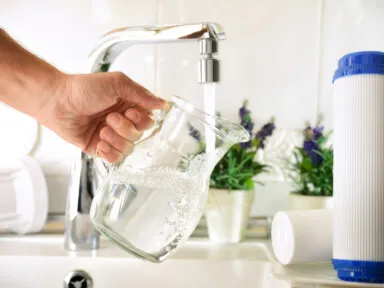Clean water is something we often take for granted. But did you know your tap water could contain contaminants like heavy metals or chemical pollutants? Unfiltered water may include substances like lead, other heavy metals, and tiny microorganisms—things you definitely don’t want in your glass.
That’s where water filters come in. They’re designed to reduce impurities, improve taste, and make your water safer to drink. Whether you’re worried about health risks or just want better-tasting water, a water filter is a simple and effective way to improve your water quality.
In this article:
- Understanding Water Filters
- Types of Water Filters
- How Water Filters Work
- Common Contaminants Removed by Water Filters
- Choosing the Right Water Filter
- Find Your Water Filter
Understanding Water Filters
Water filters clean your drinking water by reducing impurities such as chlorine, heavy metals, and bacteria. Whether it’s a kitchen sink filter, a small countertop filter or a whole home water filter system, the goal is the same: to give your household cleaner, better-quality water.
Filtering water at home isn’t just about health; it’s also about convenience and sustainability. Filtered water helps reduce your reliance on bottled water, saves money, and helps the environment by cutting down on plastic waste. A water filter is an investment that makes a big impact on your health and the planet.
The Basics of Water Filtration
Water filtration is simple. Tap water flows through materials like activated carbon, reverse osmosis membranes, or ultraviolet light to help remove or neutralize contaminants. These impurities range from visible particles like dirt and sediment to invisible threats like bacteria, viruses, and harmful chemicals. For example, carbon helps remove chlorine to improve taste, while reverse osmosis filters out microscopic pollutants, including lead and arsenic.
Why Water Filtration Matters
A water filter does more than help protect your health; it enhances your everyday experience. By reducing contaminants like lead and pesticides, water filtration protects vulnerable groups such as children and the elderly. It can also improve the taste and smell of water, making it better for drinking, cooking, or brewing coffee.
Beyond personal benefits, using a water filter supports sustainability. It reduces reliance on bottled water, saving you money and cutting down on single-use plastic bottles that harm the environment. A filter is a small step that delivers significant benefits for both your health and the environment.
Types of Water Filters
Water filters come in many forms, each designed to solve specific water problems. Whether you’re tackling bad taste, harmful contaminants, or hard water, there’s a filter to match your needs. Here’s a quick look at the most common types:
Catalytic Carbon Filters
Affordable and easy to use, catalytic carbon filters improve water quality by filtering out chlorine, chemical contaminants, and odors. However, they don’t address heavy metals or microorganisms, making them ideal for water that’s already chemically treated.
Reverse Osmosis Filters
If your water has a high level of contaminants like heavy metals, pesticides, or nitrates, reverse osmosis water filtration is a powerful choice. These systems require professional installation and use extra water during filtration.
UV Water Purifiers
Perfect for households worried about bacteria and viruses, UV filtration is a chemical-free process that neutralizes microorganisms without altering water’s taste. That said, these systems don’t remove chemicals, heavy metals, or sediment, so they’re often combined with other filters.
Comparing Pros and Cons of Each Type
Ultimately, the best filter depends on your starting water quality and what you want to achieve. Whether you’re targeting taste, contaminants, or hard water, understanding these pros and cons is key to choosing the most effective solution for your needs.
How Water Filters Work
Water filters use a mix of physical, chemical, and sometimes biological processes to help remove impurities and improve water quality. By targeting contaminants like dirt, chemicals, heavy metals, and microorganisms, filters ensure your water is cleaner, safer, and better tasting. Different types of filters are designed to tackle specific water challenges.
Mechanical Filtration
Mechanical filtration works like a sieve, physically trapping particles like dirt, sand, and rust. Filters with fine mesh or screens help remove larger impurities, preventing them from clogging your water system or making your water cloudy. Mechanical filtration is often the first step in multi-stage systems, ensuring water flows smoothly through subsequent processes.
Chemical Absorption
This process uses activated carbon, which has a highly porous surface, to absorb harmful substances like chlorine, pesticides, and volatile organic compounds (VOCs). As water passes through the carbon, contaminants bond with the carbon’s surface, leaving the water cleaner and better tasting. Chemical absorption is especially effective for improving the flavor and smell of tap water.
Ion Exchange
Ion exchange technology swaps hard water minerals like calcium and magnesium with softer ions like sodium or potassium. This process softens the water, making it gentler on appliances and pipes while also improving its taste. Commonly used in water softeners, this method highlights the difference between water filters vs. water softeners — filters remove contaminants, while softeners address hard water issues through ion exchange. Water softening is essential for households dealing with hard water.
Common Contaminants Reduced by Water Filters
Water filters are designed to address a wide range of harmful substances, making your water cleaner and safer to drink. Here are the most common culprits they remove:
Microorganisms
Unfiltered water can have bacteria, viruses, and protozoa — tiny organisms that cause illnesses like diarrhea or stomach infections. Filters with UV technology or reverse osmosis systems effectively reduce the risk caused by these pathogens. UV neutralizes, while RO filters out harmful microorganisms, making your water safer to drink.
Chemical Pollutants
Chemicals like chlorine, pesticides, and industrial pollutants can contaminate your water. Chlorine, added as a disinfectant, can leave an unpleasant taste and odor, and long-term exposure could pose health risks. Activated and catalytic carbon filters remove these chemicals, improving water taste. Advanced systems like reverse osmosis also help filter out pesticides and industrial contaminants.
Heavy Metals
Heavy metals like lead, mercury, and arsenic are among the most dangerous contaminants in water. Even small amounts pose risks, especially to children and pregnant women. Reverse osmosis and other filters help remove toxic substances, protecting your family’s health. By tackling these contaminants, water filters make your water safer, tastier, and healthier to drink.
Choosing the Right Water Filter
Finding the perfect water filter might seem overwhelming, but it doesn’t have to be. By focusing on your specific needs, you can narrow down your options and invest in a filter that delivers the cleaner, safer water you deserve.
Assessing Water Quality
The first step is understanding what’s in your water. Does your tap water have a strange taste or odor? Are you concerned about contaminants like lead, chlorine, or bacteria? You can use a home water testing kit or request a water quality report from your local supplier. Once you know the problem, you can find a filter designed to address it. For example, reverse osmosis systems excel at removing heavy metals, while activated carbon filters work well for chlorine and odors.
Filter Capacity and Lifespan
Not all filters are created equal when it comes to capacity and lifespan. Pitcher filters need frequent cartridge changes, while whole house water filters can last months or even years before needing maintenance. If you have a large household or consume a lot of water, a high-capacity filter might be the most economical and practical choice.
Budget Considerations
Water filters come in a wide range of prices, so there’s something for every budget. A faucet-mounted filter is budget-friendly and simple to set up, but advanced systems like reverse osmosis or whole-home filters require a larger upfront investment. The upside? They save you money over time by cutting down on bottled water, protecting your plumbing and appliances, and helping protecting your health from contaminated water.
Find Your Water Filter
Water filters are a simple but powerful way to improve the safety and taste of your water. They help remove contaminants, help protect your health, and reduce your reliance on bottled water. With so many options available, there’s a filter for every need. Cleaner water isn’t a luxury; it’s essential.
Learn more about the water filtration and softening systems at Leaf Home.



